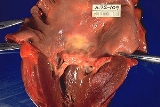
Rheumatic fever
Overview
Rheumatic fever is an inflammatory disease
that occurs following a Streptococcus pyogenes
infection, such as strep throat
or scarlet fever
. Believed to be caused by antibody
cross-reactivity
that can involve the heart
, joint
s, skin
, and brain
, the illness typically develops two to three weeks after a streptococcal infection. Acute rheumatic fever commonly appears in children between the ages of 6 and 15, with only 20% of first-time attacks occurring in adults.
Disease
A disease is an abnormal condition affecting the body of an organism. It is often construed to be a medical condition associated with specific symptoms and signs. It may be caused by external factors, such as infectious disease, or it may be caused by internal dysfunctions, such as autoimmune...
that occurs following a Streptococcus pyogenes
Streptococcus pyogenes
Streptococcus pyogenes is a spherical, Gram-positive bacterium that is the cause of group A streptococcal infections. S. pyogenes displays streptococcal group A antigen on its cell wall. S...
infection, such as strep throat
Strep throat
Streptococcal pharyngitis, streptococcal tonsillitis, or streptococcal sore throat is a type of pharyngitis caused by a group A streptococcal infection. It affects the pharynx including the tonsils and possibly the larynx. Common symptoms include fever, sore throat, and enlarged lymph nodes...
or scarlet fever
Scarlet fever
Scarlet fever is a disease caused by exotoxin released by Streptococcus pyogenes. Once a major cause of death, it is now effectively treated with antibiotics...
. Believed to be caused by antibody
Antibody
An antibody, also known as an immunoglobulin, is a large Y-shaped protein used by the immune system to identify and neutralize foreign objects such as bacteria and viruses. The antibody recognizes a unique part of the foreign target, termed an antigen...
cross-reactivity
Cross-reactivity
Cross-reactivity is the reaction between an antibody and an antigen that differs from the immunogen. It is sometimes also referred to as crossimmunity or cross-protective immunity...
that can involve the heart
Heart
The heart is a myogenic muscular organ found in all animals with a circulatory system , that is responsible for pumping blood throughout the blood vessels by repeated, rhythmic contractions...
, joint
Joint
A joint is the location at which two or more bones make contact. They are constructed to allow movement and provide mechanical support, and are classified structurally and functionally.-Classification:...
s, skin
Skin
-Dermis:The dermis is the layer of skin beneath the epidermis that consists of connective tissue and cushions the body from stress and strain. The dermis is tightly connected to the epidermis by a basement membrane. It also harbors many Mechanoreceptors that provide the sense of touch and heat...
, and brain
Brain
The brain is the center of the nervous system in all vertebrate and most invertebrate animals—only a few primitive invertebrates such as sponges, jellyfish, sea squirts and starfishes do not have one. It is located in the head, usually close to primary sensory apparatus such as vision, hearing,...
, the illness typically develops two to three weeks after a streptococcal infection. Acute rheumatic fever commonly appears in children between the ages of 6 and 15, with only 20% of first-time attacks occurring in adults.

